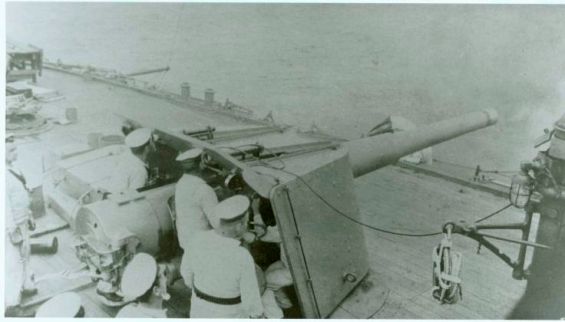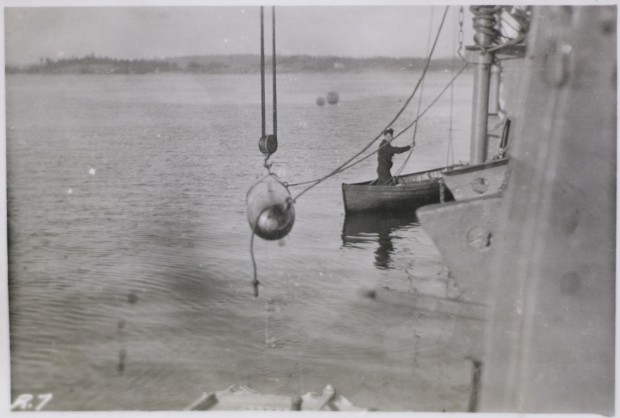
Designed as a larger follow-on to the Medea’s, which had been fitted with six 6-inch Breech Loading (BL) Rifles, the Apollo’s only mounted two of these weapons, fitted at the bow and the stern. During the early 1890s the Royal Navy was introducing medium caliber Quick-Firing (QF) guns[1], and by the end of the Apollo building program a 6-inch/40 QF gun was coming into service.[2] The long, heavy barrel of over seven tons had a three-motion breech that took a brass cartridge case containing high-powered cordite propellant in place of the previous bulky, bagged black powder propellant. The brass cartridge was not only safer but permitted quicker loading of the weapon, resulting in a more rapid rate of fire[3]. The new weapon replaced the 6-inch/26 in the last three of the Apollo’s launched and appears to have been back-fitted into most of the remaining ships in the class[4]. Certainly, by the time she was commissioned for Canadian service, Rainbow had been re-equipped with the 6-inch/40 Mark II QF gun.
The 4.7-inch gun
The substitution of the 4.7-inch QF weapon for the older broadside mounted 6-inch BL in the Medea’s marked the major departure of the Apollo class design. The 4.7-inch/40 QF featured a new cordite propellant in brass cartridges. This new weapon’s 45-pound shell had nearly the same penetrating power and range as the 100-pound shell of the 6-inch/26 gun and was capable of up to twelve rounds per minute[5]. Thus, the effective weight and penetration power per minute achieved with this battery was a considerable improvement over the preceding Medea class’ uniform battery of slow-firing 6-inch BL rounds.
Smaller weapons

The development of the torpedo by Robert Whitehead in 1866 and the subsequent introduction of a small, fast torpedo boat to launch it presented a new threat to battleships and cruisers. To defend against torpedo boat attacks, larger ships were provided with a battery of smaller weapons capable of the high rate of fire considered necessary to obtain a hit on the boat outside torpedo launching range. The operating concept since the 1890s was to use a heavy weapon to break through armor and a rapid-fire lighter gun for riddling unprotected portions of the ship and inflicting personnel casualties[6]. For the Apollo’s this light battery consisted of eight 6-pounder QF guns. Two were mounted on each broadside between the 4.7-inch secondary guns, two to fire through embrasures in the bow, and two to fire through embrasures in the stern[7].
The 6-pounder fitted was a Hotchkiss Mark-I 8cwt design[8], however the utility of such a light weapon against torpedo boats was already being questioned by the time the Apollo’s were launched[9]. Trials conducted in 1889[10] had determined that an effective engagement against a fast moving torpedo boat would occur between 500 and 1000 meters.[11] The trials also indicated that a 12-pounder was the smallest shell that would likely disable a torpedo boat with single hit so smaller weapons, like the 6-pounder had to rely on mass effect from rapid broadside firing to achieve the volume necessary in the time available to defend against a torpedo boat attack[12]. The Apollo’s also carried a single 3-pounder[13] for use in the ship’s boat presumably as support to landing party operations. The typical 3-pounder of the day was a Hotchkiss Mark 1 on a low angle mounting, which fired a 47mm 3.3 pound shell out to about 6500 yards. Finally, there was also a field gun for use by shore parties.
Torpedoes:

Rounding out the Apollo’s armament was the torpedo outfit. The RN had had some considerable experience with the rapidly evolving torpedo technology by the time the Apollo’s were designed. The first British version, produced by the Royal Laboratories in 1876 as the Mark I, was followed by a rapid succession of improved designs. By 1883 the Mark VIII was introduced, a variant that would remain in service into the 1900s.[14] The original Whitehead design solved some of the most significant problems confronting a submerged automobile weapon: that of accurate depth control. To solve this simple but ingenious combination of hydrostatic pressure and a pendulum was used[15]. It was not until the turn of the century that a clockwork gyroscope was introduced to torpedoes to govern lateral movement, thus increasing the practical range of a torpedo beyond 1000 yards[16].
